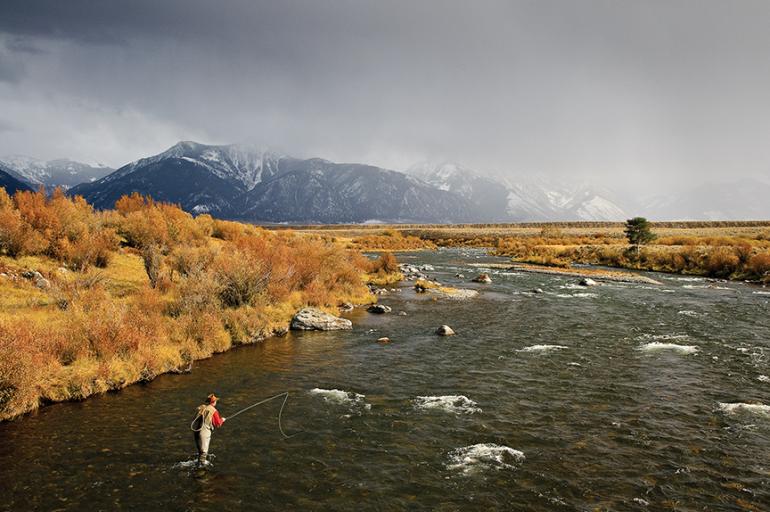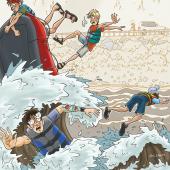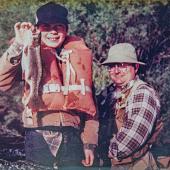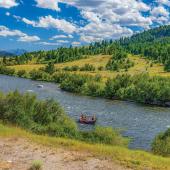The Mythical Madison
A study of the iconic Madison River.
Every sport has its iconic, generation-transcending locales: baseball has Yankee Stadium; golf, the back nine in Augusta; football, Lambeau Field. And fly fishing has the Madison River. Steeped in lore and Western fly-fishing history, it’s on every fisherman’s worldwide bucket list. With cold, clean water, breathtaking scenery, healthy trout populations, and lots of available access, it’s no wonder that the Madison continues to be the most famous trout water on the planet.
From Madison Junction downstream to where it exits Yellowstone Park, the river is under the authority of the National Park Service, and a special fishing license and regulations apply. From the Park boundary, the Madison follows a leisurely course until it reaches Hebgen Lake, the largest of the Madison River impoundments. From here, the Madison flows a short distance to Quake Lake. Below the lake, the Madison starts what is known as the 100-mile riffle in its journey downstream to Ennis Lake. The Madison has both the biomass and stable flows of a tailwater, with the variation in insect life and structure of a freestone. It is quite possibly the perfect trout stream.
Access
The upper Madison is blessed with numerous, well-developed access sites. A combination of FWP and BLM sites are conveniently located about every five river-miles, and are some of the best-developed sites in the state. Lyons Bridge and Palisades are a few favorites for float anglers. Valley Garden near Ennis and Reynolds Pass below Quake Lake are some of the wade fisherman’s favorite places to wet a line.
Flows
Thanks in large part to the controlled release of water from Hebgen Dam, the upper Madison does not see the prolonged spring runoff or the skeleton flows of August that some other rivers face. The water may become discolored and unfishable from runoff, but that is usually short-lived. Summer flows usually remain stable and provide enough water to safely float, but not enough to make wade fishermen scramble for other areas.
When to Go
When is the best time to fish the Madison? Whenever you can. The Madison, like most rivers in Montana, has somewhat predictable hatches and water conditions that make fishing more successful. The highlight of the year is the salmonfly hatch from mid-June till mid-July. These three-inch-long floating T-bones from heaven drive the fish wild and provide the best opportunity to catch a really large fish on a dry. Most years, the Madison is the most heavily fished river in the state, with the majority of the use coming during the mid-June-till-Labor-Day window. Even during the busy times, however, the crowds clear once past the access site. Lastly, do not overlook the shoulder seasons of April, May, and October. The relative solitude will only be interrupted by those pesky hungry fish.
The Fish
The upper Madison is known the world over for its hard-fighting rainbow and brown trout as well as mountain whitefish. The rainbow population has rebounded from its lows during the early ‘90s and whirling-disease issues, thanks mostly to efforts to protect spawning fish and improvements in river management. Brown trout can be found river-wide and several specimens in excess of 25 inches are caught each season. The mountain whitefish, one of the true natives to the drainage, has come under hard times with their population declining in the past few years. Cutthroat trout, once native and plentiful in the Madison, are now reserved as an oddity with strongholds in many of the feeder creeks. A few cutties are found in the main river, primarily near the mouths of small creeks.
Row vs. Wade
This is where the Madison really shines. The river has two areas that are off-limits to boat-fishing, to cater to wade-only fishermen. Boats can be used to access the river, but fishing must be done with your feet in the water. The upper wade stretch is from the outlet of Quake Lake downstream to Lyons Bridge, and is characterized by fast riffle water and large boulders. The lower wade-only area is from Ennis Bridge downstream to Ennis Lake, known locally as the channels section. The Valley Garden access near Ennis is the only access to these channels.
Regulations
Besides the areas set aside for wade fishing, the Madison has a few special regulations for fishermen to keep in mind. First, the river upstream from McAtee Bridge to Quake Lake is closed from the end of February until the second Saturday in May to protect spawning rainbow trout. From Varney Bridge to Quake Lake, the river is catch-and-release and restricted to artificial lures or flies only. Below Varney Bridge, anglers are allowed to keep brown trout as well as fish with bait. As always, check the annual regulations before hitting the river.
Getting There
The easiest way to fish the upper Madison from Bozeman is to follow Hwy. 84 to Norris, then take a left and proceed to the quaint fishing hub of Ennis. Stop by one of the local fly shops and pick the brains of some local experts, then proceed south on Hwy. 287, which conveniently parallels the Madison its entire length.
Hotspots
The area from Lyons Bridge downstream to Ennis is the primary float-fishing section on the entire river: roughly 40 floatable river miles and more trout than one can catch in a lifetime. Popular floats on this stretch start at Lyons Bridge and McAtee Bridge.
John Way is an outfitter and the owner of the Tackle Shop in Ennis.












